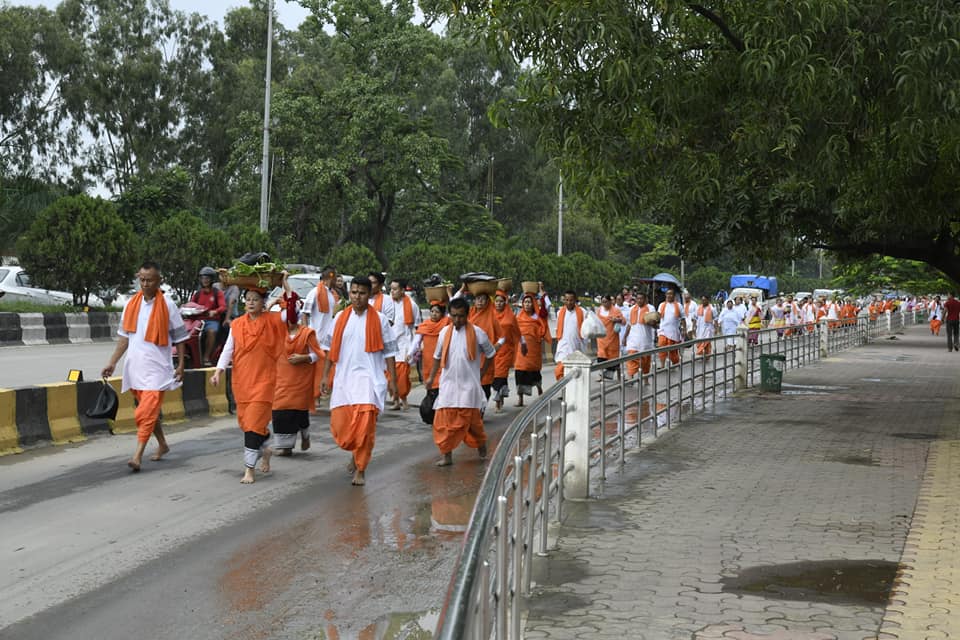Meetei worships Tangkhul women as a Goddess and the presence of Tangkhul brothers and sisters is mandatory during Lai Haraoba of Ima Nongpok Ireima. The Meetei goddess, Nongpok Ireima is a Tangkhul woman. She was married to a Meetei king Tabungba.
Irengba married the daughter of Tangkhul Chief Khayingba, Pidongnu Nuphabi. which is known as Haoreima Tamheibi by the Meetei.
The Leirum (Tangkhul phee) which is an important gift in every Meetei marriage is her father’s (gift) to the Meetei king.
Interestingly the Chingdai Khullakpa (headman) Khayingba was the second son of Thingol Likmaba of the Khuman principality. He went up to the hill to become a hillman and later became the chief of Chingdai village.
King Paikhomba married Ingallei (Matrimei), daughter of Maram Khullakpa. The last royal blood of King Pakhangba, Charairongba was their son.
The romantic relationship between the Meetei king Paikhomba and Maram tribal woman Ingallei, and the tragic end of Ingallei are soul-stirring episodes in the personal relation of a Meetei king with the hill people. The abode of Ingallei is still located at Langol Hill, and the deity of the abode is known as Tarung Lairembi in the Imphal West district.
King Charairongba too married a Chothe woman.
All these suggest Manipur is a land for the Meetei, Tangkhul, Maram, Chothe, Anal, Thangal, Kabui, and various other tribes. The land is not for Kuki or Naga.
We have to sit together and read history and keep that bonding intact who are trying to break the land with vested interest only.
The word “Naga” and the new religion “Christianity” came only 200 years ago. We have to read and understand history beyond this period!
When the colonial administrators and missionaries first visited the Naga Hills, the tribals used to identify themselves with a particular tribe and not as a Naga.
The name “Naga” was given to them by the people of the Assam plains and in the last century was used indiscriminately for the Abhors and Daflas as well as for the Nagas themselves.
The word, Naga and Nagamese came into vogue at the same time in the closing years of the Nineteenth century. Nagamese, a form of Assamese enlivened by tribal words, is what the Nagas spoke with the plains people of Assam for centuries, which later on became the lingua franca over a loosely defined territory.
Definition and the probable meaning of the term Naga was defined by Prof Gangmumei Kamei in his book “History of Manipur (Pre Colonial Period) as a derivative from the Sanskrit word Nag (snake) or Nagalogae or Nagalog, which signifies Naked. Another view from the Myanmar side supported that the word Naga is derived from the Ear-piercing tribes.
More researchers are of the opinion that the term Naga is mostly suitable for Naked people who live in the forest where no one can enter. Further studies by the Britishers show there were still naked people living in the Naga Hills.
Our study reveals that there are no naked tribes in Manipur. We have rich civilizations and tribes living in the hills of Manipur and we have different clothes which are colorful and have symbolic meaning. Although British missionaries came along with the Bible, they did not bring the dress and culture to the land.
Dress worn by the Tangkhuls were beautifully woven and crafted over the ages. Haora and Changkhom of the Tangkhul tribe are filled with their own distinct design and pattern.
How can we call them the Naga (naked) tribe if the above definition of Prof Gangmumei Kamei is confirmed as the only legitimate meaning of Naga? So, Tangkhuls are not naked tribes.
Meetei worships Tangkhul women, not any Naga women!
(C) Naorem Mohen
The writer can be reached at Twitter @laimacha
Editor | Signpost News







Comment on “Do you know Meetei worships Tangkhul women”